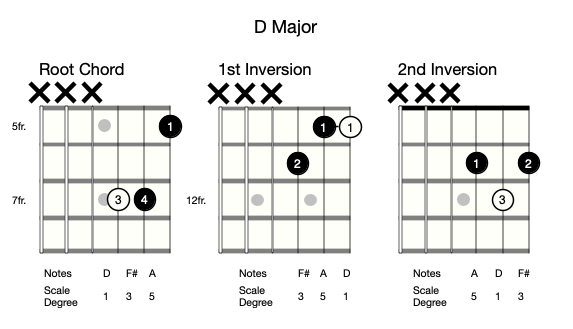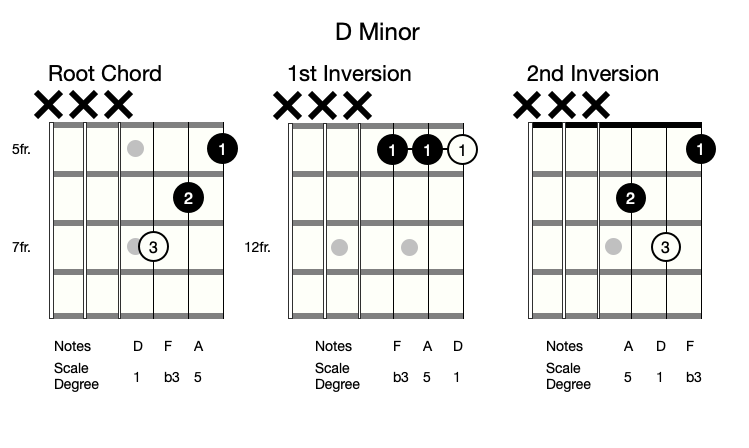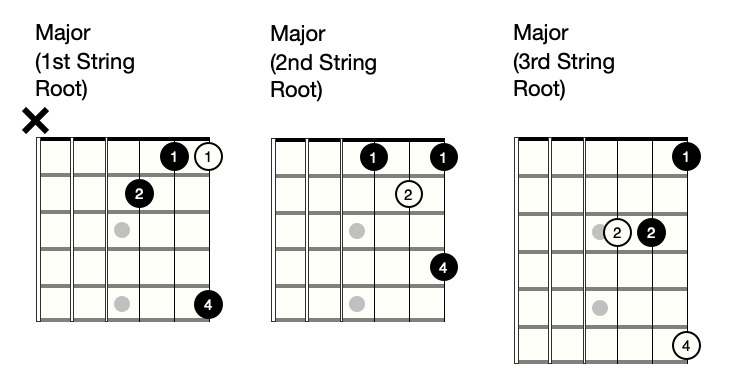In general, there are 3 ways to approach soloing on the guitar:
Completely free-form, using your ear
Using scale shapes to match the key of the song or the chords
Using arpeggio shapes to match the chord being played
In my experience, getting to number 1 is the ultimate aim, but to get there, you’re most likely going to have to use a lot of number 2 and 3 first to train your ears and your fingers to hit the notes you want.
Most guitarists start out soloing with scales, and in particular, using the Minor Pentatonic scale as it’s a super versatile and common scale for a heap of genres and styles. After that, you only really need two other scales to cover the other notes you’ll want:
The Major Scale
The Harmonic Minor Scale
With a bit of theory knowledge, you can use these three scales (including the Minor Pentatonic) to get all sorts of awesome sounds.
If you’re not sure how to go about this, check out this guide to The Only 3 Scales You Need for guitar solos.
In this article, I want to focus on number 3 - effectively using arpeggio shapes for lead guitar playing.
What do we mean by arpeggio shapes in lead guitar?
Arpeggios are chords. Specifically, they’re the notes that make up the chords played separately.
If you hold down an open C Major chord and pick through the notes one at a time, that’s a C Major arpeggio.
However, when we’re in lead-guitar-land, and in particular electric-guitar-land, this approach to arpeggios isn’t what we usually want to hear. If you put on a heap of distortion and play through the notes of the C Major chord, you’ll end up with a big wall of noise - definitely useful in certain circumstances, but rarely in the middle of a guitar solo as it’s too overbearing and the individual note phrasing gets lost.
Instead, we typically pick through the notes of the arpeggio one at a time, stopping each note from ringing when we start the next note.
It’s a lot harder to do, but it’s much clearer and more melodic sounding for lead-playing.
The Best Guitar Arpeggio Shapes for Guitar Leads
When we’re talking about arpeggios, all the names match the chord names, so if you already know a bit about chord theory and playing chords all over the fretboard, the theory side is no different. I’ll interchangeably use the term “arpeggio” and “chord” throughout this article, as remember, the only difference is when we say arpeggio we mean separating the notes instead of playing them all at once.
Just like there are 3 scales you need for soloing, there are 3 arpeggio shapes you’ll want to master:
Major Triad
Minor Triad
Diminished Triad
‘Where are the 7ths, the 9ths and all the other variation chords?’ you may ask. Technically, you can build all of those other chords using these triad shapes, or at the very least, by modifying a note here and there, so you don’t necessarily have to practice a Major 9th Arpeggio shape, for example, to actually play a Major 9th chord.
Confused? Let me give you an example to explain.
A C Major 9 Chord is made up of the following notes:
C - E - G - B - D
which are the following scale degrees from a C Major Scale:
1 - 3 - 5 - 7 - 9
If I play a C Major arpeggio shape, I’m going to be playing the notes:
C - E - G (or 1 - 3 - 5 from the C Major 9 Chord)
To get the B and the D, I can just use a G Major triad, which has the notes:
G - B - D (or 3 - 5 -7 from the C Major 9 Chord).
So, if I want to create a C Major 9 chord sound, I can just mash a C Major and a G Major arpeggio shape together.
However, that doesn’t mean you shouldn’t learn 7th or 9th arpeggio shapes too. It’s more that you should not think of each shape you learn as a completely new shape. Think of your arpeggio shapes as building blocks that you can a arrange however you want. Yes, a C Major 9 Arpeggio Shape is a C Major 9 Arpeggio Shape, but if you take part of the shape, you’ll have a C Major, or another part and you’ll have a G Major, or even an E Minor if you take another part. And similarly, if you quickly move between a C Major, G Major and/or an E Minor shape while the rhythm section is playing a C Major chord, you’ll get a C Major 9 sound.
If this sound complicated, it can be, especially compare to scale-based playing, but don’t worry - if you start by learning the shapes and using them in simple situations first, you’ll start to get a feel for how to put the shapes together intuitively when actually soloing.
The Major and Minor Arpeggio Shapes
I recommend starting out with 3 string arpeggio shapes on the top 3 strings to begin with, which I know may be different to what you’ve done in the past if you’ve already got some experience with arpeggios.
The reasons are:
3 string arpeggio shapes don’t double up any notes. As such, they’re very efficient and it’s easy to learn which note is which in the arpeggio, which is very important to know.
Most soloing happens on the higher strings, so you’ll likely use these shapes a lot more often than other arpeggio shapes.
If you want to do sweep picking and sweep arpeggios, these are the easiest ones to use both from a technical and a theory perspective.
Each of the following examples is a D Major chord, but with the root note on a different string for each option. (root notes marked in white).
Technically, we name these chords based on the order of the notes.
If I play the notes in the order 1 - 3 - 5, it’s a root chord.
If I play the notes in the order 3 - 5 - 1, it’s a 1st inversion.
If I play the notes in the order 5 - 1 - 3, it’s a 2nd inversion chord.
That doesn’t really matter too much when soloing as you can play the notes in any order you want, so don’t worry too much about remembering that for now - just focus on remembering where the root notes are.
For the Minor shapes, it’s basically the same thing but we’ve just moved the 3rd down a semitone (or one fret):
It’s a lot of shapes to remember, so take your time with this. Stop and think about WHAT you’re playing, as that’s going to be far, far more useful than how you play it at this stage.
How to Practice the Arpeggio Shapes
You can just pick through the notes up and down, double up notes - whatever you want. It’s just like a scale, but a scale with only 3 notes.
However, if you want to do faster playing, then the following shapes will be useful, as they are excellent for sweep-picking. They don’t add any any new note names, just extra octaves of the same notes.
I won’t go into the technique side of things for sweep picking in this article as you don’t HAVE to do sweep-picking to use arpeggios, but if that’s what you’re most interested in, check out this guide to Sweep Picking for Guitar.
Try moving between different shapes as you go, as we typically jump between a lot of arpeggio shapes when soloing and that’s where most of the technique challenges will lie.
The Diminished Arpeggio Shape
This chord is incredibly useful for adding tension and dissonance to your solos. It’s used in classical, jazz and metal as what I call a “filler lick”, great for connecting up different musical ideas even if they’re in different keys, tempos or even styles.
A diminished arpeggio is made up of the 1st, flattened 3rd and flattened 5th notes of the major scale, so it’s only one note different to a minor arpeggio.
For example, C Diminished has:
C - Eb - Gb
Here’s the shapes in D Major:
How to Use the Diminished Arpeggio Shapes
It’s all the same as the major and minor shapes really, but to sweep the triads it’s easier to add in the double-flat 7th from a diminished 7th chord on the root chord shape - functionally it makes little difference when we’re talking about diminished chords, just remember that we have actually added a note and that may alter the sound you’re going for.
The other two shapes are a bit tricky to play so I’d generally stick to the root position chord when sweeping.
The really cool thing about diminished arpeggios is that they are super easy to use as there are actually only 3 diminished chords that exist due to the arrangement of the notes.
The best way to practice them, as this is the way they’ll come up the most in solos (and likely the way you’ll want to use it the most too) is to play the root shape, move up 3 frets, do it again, then move up 3 frets and do it again. Congratulations! You’ve just played all 3 diminished chord shapes, combining them into a massive diminished run. And because that pattern covers all the diminished chords, you can use it ANY time you want a diminished sound, in any key, in any style, no matter which fret you start from!
How to use the arpeggio shapes to solo
The easiest way to start with these shapes is to make a backing track with 2 - 4 major chords. Let’s say we want it to be:
D - G - Em - D
First, try playing each of those arpeggio shapes over the relevant chord - for example, play a D Major arpeggio when the backing track is on D, then G over G and so on.
It’ll take a bit of practice, so give yourself a lot of time on each chord to begin with. I’d recommend sticking with one arpeggio shape to begin with too (really 2, as you’d use the major and the closest minor shape), just sliding it up and down the neck to match the chords, then you can introduce the other shapes as you get more confident.
At this point, you’ll probably notice that whilst the notes you’re playing fit the chords, in the words of Frank Gambale, they sound “frightfully dull, chaps!”
And that’s true - we’re currently only playing safe, consonant notes, which is boring.
So next, take those arpeggio shapes and mix them in with other notes from the relevant major scale or by using your ears.
For example, I might start playing the D Major triad shape, then add in an E somewhere randomly. It’s not part of the D Major triad, but it is part of a D Major scale, so it should still fit and will break up the arpeggio sound nicely. Maybe throw in a diminished arpeggio somewhere to spice things up.
In other words, we use the arpeggio shapes as the skeleton to solo around.
The skeleton is showing you all of the safe notes, and you can use your other patterns and creativity to hit all the other non-safe notes to vary it up.
It’s all about understanding what you’re playing over.
As you can probably tell, the big secret to using arpeggios in your solos isn’t really the technique, it’s the knowledge of when to use each shape.
Really understand the chords you’re soloing over and choose arpeggios that fit it. I gave you the simple option in this article of playing the same triad as the chord you’re playing over, but you can easily do things like play a G Major arpeggio over a C Major chord to get a C Major 9 sound, for example.
Similarly, there are heaps of different arpeggio shapes you can use and learn, but remember:
Learning arpeggio shapes is useless unless you learn when to use it.
So each new shape you learn, whether it be a simple 3 string arpeggio or a monstrous altered chord, you need to try over lots of different chords to work out when it sounds good and when it doesn’t. Theory will help a lot for this, but a lot of it is personal preference too.
What Arpeggios Should I Learn Next?
Once you feel like you’ve done all you can with the shapes above, there are a heaps of ways you can branch out. I’d recommend (in no particular order, as it depends on what styles you’re playing):
Learning other 3 note arpeggios on other strings
Putting these shapes together into 4, 5 or 6 string arpeggios
Augmented triads, 7ths, 9ths and other chord shapes
Changing arpeggios faster (for example, play two notes from an E Minor arpeggio, then pivot to a G Major)
If all of this sounds like a lot of work, you’re right, it is when we’re talking about a full song! But, it’s upfront work for long-term payoff, as if you take a song and REALLY understand the chords and the arpeggios to use, your solos will sound exceptionally well thought-out and smooth. I can’t stress this enough - sometimes all it takes to improve a solo is to say “hey, the chords are going Em, Dm, C, so if I just use those arpeggio shapes over that bit of the run it’ll sound a bit nicer”.
9/10 when someone goes “oh that part of the solo you did there was really cool” all I’ve done is add in one easy arpeggio shape over one chord! So start small and see what arpeggios do for your playing.
Written by Ben Plant - Pathfinder Guitar
Ben's the space-faring guitarist from Hybrid Nightmares, the masters of progressive extreme metal renown for their stage shows. He's also the founder of Pathfinder Guitar, where he and his team of teachers help guitarists find their path towards guitar mastery.






